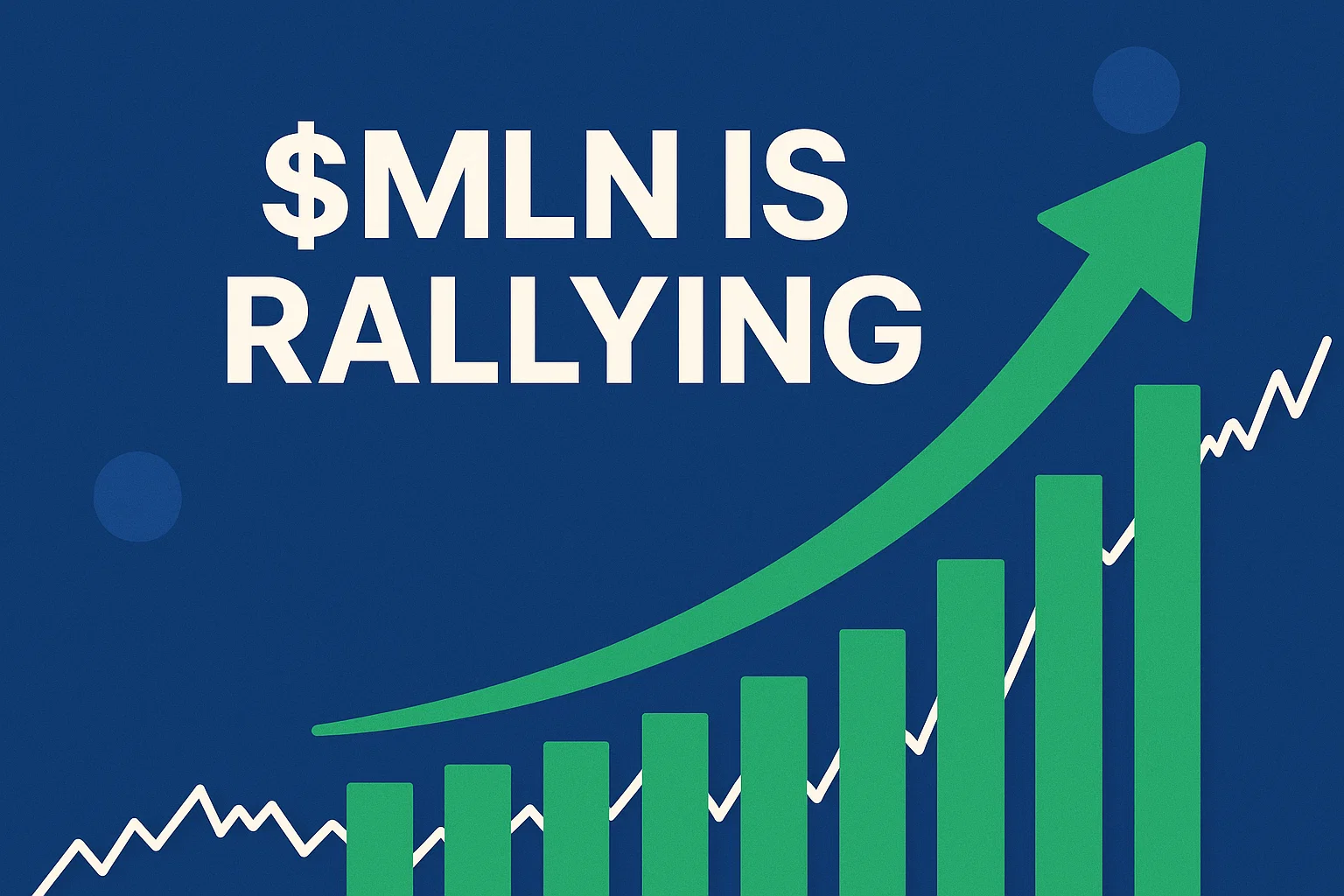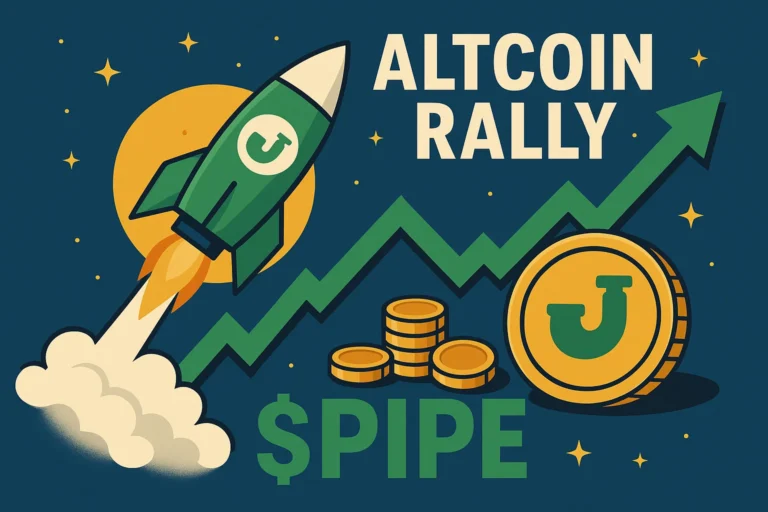In this latest altcoin rally, three tickers have captured outsized attention: $PIPE, $SERAPH, and $MLN. Each sits in a very different corner of crypto—Solana memecoins for $PIPE, AAA gaming for $SERAPH, and DeFi asset management for $MLN—yet all three share a simple story: renewed liquidity, fresh catalysts, and traders hunting momentum.
This article breaks down why the market is rallying, what’s unique about each token, where the momentum might go next, and how to manage risk without getting wrecked. We’ll keep the jargon light, the insights practical, and the narrative focused so you can make sense of the move without chasing blindly.
Why Altcoins Are Ripping Right Now
Every strong altcoin rally starts with the same ingredients: a green macro backdrop, improving crypto liquidity, and narratives that give traders a reason to buy. When Bitcoin dominance cools after a sharp BTC leg higher, capital often rotates into smaller caps. Analysts have been calling for this kind of broad “altseason” setup throughout the year as the total altcoin market cap carves higher lows and breaks consolidation ranges. That rotation dynamic is precisely what we’re seeing: capital flow leaving relative safety and seeking higher beta in mid- and small-cap names.
Market structure matters. After long periods of chop, even modest fundamental news can trigger significant percentage moves in thinly traded names. That’s why you’ll often see memecoins, gaming tokens, and DeFi governance assets spike first—they’re narrative-heavy, sentiment-driven, and highly responsive to speculative flows. With that backdrop, let’s zoom in on the day’s leaders.
$MLN DeFi’s Veteran Finds New Momentum
What is $MLN (Enzyme)?
Enzyme (ticker: MLN) is a battle-tested DeFi protocol that lets anyone spin up on-chain asset management strategies—think actively managed crypto funds, automated strategies, or structured products, all governed by smart contracts. The MLN token powers fee mechanics and governance within Enzyme’s ecosystem and has been around since the Melon Protocol days, giving it unusual longevity for a DeFi project.
Why $MLN is rallying
Among today’s leaders, $MLN posted one of the most eye-catching daily surges, supported by a jump in trading volume. As of today’s session, CoinMarketCap showed MLN up strongly on the day with elevated volumes and a multi-million dollar turnover, signaling real participation rather than a low-liquidity wick. The market-cap-to-volume ratio tightened as buyers stepped in, and the protocol’s reported TVL provides a fundamental anchor that many “hot” tokens lack.

That matters because TVL and product-market fit can transform a sugar-high pump into a sustained trend. Enzyme’s pitch—composable on-chain asset management—speaks to power users and institutions experimenting with tokenized portfolios. The narrative is timely: tokenized finance and on-chain funds are a growing theme, and platforms that lower operational friction for professional allocators sit in that slipstream.
Key levels and structure to watch
Without drawing lines on a chart, two things stand out:
-
Range expansion: When an asset clears recent highs on rising volume, momentum traders look for continuation. That’s precisely the type of action MLN displayed today, with a wide intraday range that included a strong high print versus the session low.
-
Legacy reference points: MLN’s all-time high is historically far above today’s levels (a reminder of both upside potential and the risk of long-term drawdowns). Veteran DeFi names can re-rate quickly during risk-on windows, but they also retrace fast if the altcoin rally cools.
$SERAPH AAA Loot, Game Economy, and a Relentless Bounce
What is $SERAPH?
Seraph (SERAPH) is the token for Seraph Studio’s “AAA loot” action RPG, a PC/mobile title that blends classic loot mechanics, NFT-based item verification, and a player-run economy. In other words, it’s a web3 gaming bet with traditional game-feel ambitions. The token is categorized under gaming and Binance Alpha on major data sites, with a circulating supply below the hard cap and active exchange listings.
Why $SERAPH is rallying
Gaming tokens tend to move in bursts around development updates, exchange activity, and community events. Seraph’s on-chain data and live price feeds showed heavy 24-hour volume and an aggressive intraday range today. Even more telling, the token printed an all-time low only days ago and has since rebounded sharply—a classic reflexive bounce pattern as value buyers and short-term traders pile in to fade capitulation. That dynamic explains why percentage gains can look “massive” from depressed levels.
What to monitor next
For gaming tokens, the real driver isn’t just tokenomics—it’s player retention, content cadence, and marketplace liquidity. If Seraph can convert speculative attention into actual players trading rare items and engaging with the in-game economy, the rally gets more durable. If not, post-bounce digestion is likely once the initial shorts cover and momentum cools. Keep an eye on daily active users, updates from the project’s official channels, and price feeds.
$PIPE Solana Memecoin Whipsaws on Micro-Cap Flows
What is $PIPE?
PIPE is a memecoin launched on Solana, originating from the pump. A fun ecosystem that is thematically tied to the Pi community. It’s a micro-cap with extremely light reported volume and a supply structure typical of meme assets. Listings show it trades primarily on Raydium, with a recorded all-time high in February 2025 and a new all-time low this month—a snapshot that perfectly captures how violently these tokens can move in both directions.
Why $PIPE is rallying now
In every altcoin rally, a long tail of Solana memecoins wakes up as traders chase percentage gains. Because liquidity is thin, even modest buy pressure can generate oversized daily candles. That appears to be the case with PIPE: the token’s price history is punctuated by steep spikes and drawdowns, and today’s bounce fits the speculative rotation playbook more than a fundamental re-rating. This is not a judgment—just the nature of micro-cap meme markets.
A reality check on risk
The very data that makes $PIPE “pop” also underscores its risk. Coin trackers show minimal 24-hour volume and a market cap that can swing on a handful of trades. That means slippage, failed exits, and rug risk are non-trivial. If you trade these, you’re betting on virality, not valuation. Set hard stops, size positions carefully, and remember that meme rotations can end as fast as they start.
The Macro Setup: Why This Altcoin Rally Has Legs—And Limits
Rotation from BTC to high beta
Historically, intense BTC weeks are followed by rotations into altcoins as traders seek higher returns. Once Bitcoin dominance pauses, the TOTAL2 market cap (altcoins excluding BTC and ETH) often expands through a mix of narrative and leverage. Analysts flagged this possibility earlier as the altcoin market structure improved, and today’s action aligns with that thesis. Still, rotations can stall if BTC resumes vertical movement or macro headlines sap risk appetite.
Narrative density matters
Tokens with clear narratives—DeFi infrastructure like $MLN, web3 gaming like $SERAPH, and Solana memes like $PIPE—are the first ports of call when altseason talk heats up. These narratives provide story hooks that help traders justify entries and that the media can amplify, which in turn draws liquidity. The downside: narrative whiplash is real. If headlines turn or if a narrative fails to deliver fresh catalysts, momentum unwinds quickly.
Liquidity is the lifeblood.
Look closely at reported volumes and venue quality. MLN’s daily turnover on established exchanges is healthier and easier to exit than a micro-cap meme on a single DEX. SERAPH sits in the middle: lively volumes but still highly sensitive to sentiment. PIPE, by contrast, is almost entirely liquidity-driven. Understanding where your token sits on this spectrum can help you choose time horizons and position sizes that match reality.
Deep Dives: Catalysts, Valuation Frames, and Watchouts
$MLN (Enzyme): DeFi infrastructure during a tokenized-funds wave
Catalysts:
Protocol improvements, integrations with custody and compliance rails, and rising on-chain fund experiments could funnel more users to Enzyme. The TVL component also provides a semi-fundamental reference point during frothy price action.
Valuation frame:
Rather than P/E or simple FDV, watch TVL, fee capture, and active vaults. If volumes and managed assets rise in tandem with the token price, the re-rating case is stronger. If price runs ahead of usage, expect mean reversion.
Watchouts:
Regulatory uncertainty for on-chain asset management, smart-contract risks, and competition from rival DeFi asset platforms. Always review audit history and official docs.
$SERAPH: From price action to product traction
Catalysts:
Closed beta updates, marketplace milestones, new CEX listings, and content drops. The project’s AAA loot positioning invites comparisons with web2 action RPGs; if gameplay loops land, player-owned economies can compound over time.
Valuation frame:
Gaming tokens often trade on DAU/MAU growth, marketplace GMV, and item velocity. Look for on-chain hints of player activity alongside price.
Watchouts:
Game development timelines slip, and hype cycles outpace delivery. If player retention lags, the token price becomes mostly a macro-beta instrument with elevated downside beta.
$PIPE Momentum first, fundamentals later (if ever)
Catalysts:
Viral memes, Solana ecosystem tailwinds, and the occasional influencer nudge. Exchange or aggregator visibility can also spark flows. But remember, the same factors can flip bearish overnight.

Valuation frame:
Memecoins rarely map to cash flows. Think in terms of liquidity zones, community growth, and social velocity. Trade it as it is: pure beta with a story sprinkled on top.
Watchouts:
Extremely low 24h volume and market depth. Evaluate slippage on DEXs before entering. Never extrapolate thin-liquidity % moves into long-term expectations.
Risk Management for a Fast Tape
Position sizing and “tilt control”
In a broad altcoin rally, it’s easy to tilt your portfolio too far, too fast. A simple framework:
-
Anchor the core in higher-liquidity names (e.g., BTC, ETH, major L1s).
-
Express the trade with measured satellite positions in momentum names like $MLN, $SERAPH, and $PIPE.
-
Use pre-defined invalidation points rather than emotional exits.
Venue selection and exit planning
Tokens split across CEX and DEX venues trade differently. Check order book depth, fees, and withdrawal times. For micro-caps, test a partial exit before sizing up. If one data provider shows ultra-low volume for your token, assume wider spreads and higher slippage until proven otherwise.
Differentiate “momentum” from “manipulation”
Crypto’s history includes pump-and-dump cycles and coordination in thin markets. Treat unusual spikes with skepticism, check multiple sources, and remember that the space still wrestles with market integrity issues flagged by both media and regulators.
How to Approach $PIPE, $SERAPH, and $MLN from Here
Build a thesis, then trade the plan
For $MLN, your thesis might be “DeFi infra with TVL traction during a tokenized funds push.” For $SERAPH, perhaps “AAA web3 gaming with item verifiability and a growing player economy.” For $PIPE, the honest thesis is “liquidity-and-narrative momentum within Solana memecoins.”
Write your thesis down, define entry criteria (e.g., reclaim of a level on rising volume), invalidation (where you’re wrong), and position size. If price deviates from plan, act—don’t rationalize.
Keep your time horizon aligned with the asset.
-
MLN can support swing trades or medium-term positions because product fundamentals exist alongside narrative.
-
SERAPH fits event-driven trades around product updates and listings; medium-term holds depend on demonstrable player traction.
-
PIPE suits short-term momentum only; long holds require a strong stomach and community conviction.
Always verify the basics before you buy
At a minimum, check live price, 24h change, circulating supply, FDV, venue quality, and contract addresses on reputable trackers. Cross-referencing CoinMarketCap and CoinGecko takes minutes and prevents common mistakes, especially in the realm of lookalike tokens.
Final Thoughts
This altcoin rally is rewarding traders who can separate durable narratives from thin-liquidity fireworks. $MLN brings a seasoned DeFi product with real use cases, $SERAPH rides the wave of web3 gaming and a dramatic bounce off recent lows, and $PIPE exemplifies the Solana meme bid that can turn tiny flows into giant candles. The opportunity is real—but so are the risks. Respect liquidity, plan exits, and never confuse momentum with margin for error. If you can do that, you can participate in the upside without letting volatility define the outcome.
FAQs
Q: Are $PIPE, $SERAPH, and $MLN good long-term investments or short-term trades?
They can be either, but their profiles differ. $MLN has deeper DeFi fundamentals and a track record, making it more suitable for swing-to-medium term positioning. $SERAPH can work for event-driven trades that become longer holds only if player metrics rise. $PIPE is best treated as a short-term momentum play unless you have high conviction in the Solana meme meta.
Q: What makes today’s gains “massive” in percentage terms?
Altcoins—especially micro-caps—can post double-digit intraday moves when liquidity is thin and narratives are hot. That’s why MLN’s volume-backed surge stands out, while SERAPH shows how quickly prices can rebound after setting new lows. PIPE illustrates how small inflows can produce large candles in memecoins.
Q: How do I validate that a move isn’t just a manipulated pump?
Cross-check multiple data sources, look for sustained volume on reputable venues, and watch how the price behaves after spikes. Reputable analyses and enforcement actions have documented manipulation patterns in thin markets, so skepticism pays.
Q: What on-chain or product metrics should I track next?
For $MLN, track TVL, active vaults, and fee flows. For $SERAPH, watch player activity, marketplace GMV, and development updates. For $PIPE, monitor DEX liquidity, holder concentration, and social momentum.
Q: Is now the start of a broader altseason?
Market structure argues for further altcoin rotation when BTC cools, but timing is tricky. Analysts have flagged the setup before; sustaining it requires risk appetite, continued liquidity, and fresh catalysts across narratives. Keep position sizes flexible and respect invalidation levels.
See More: Top 3 Altcoins To Watch September 2025 & Investment Guide

